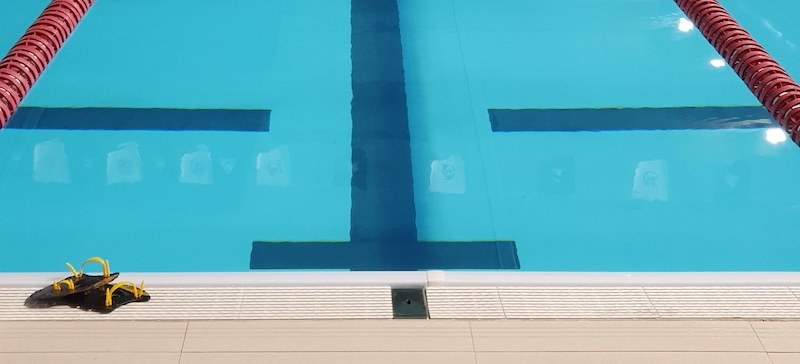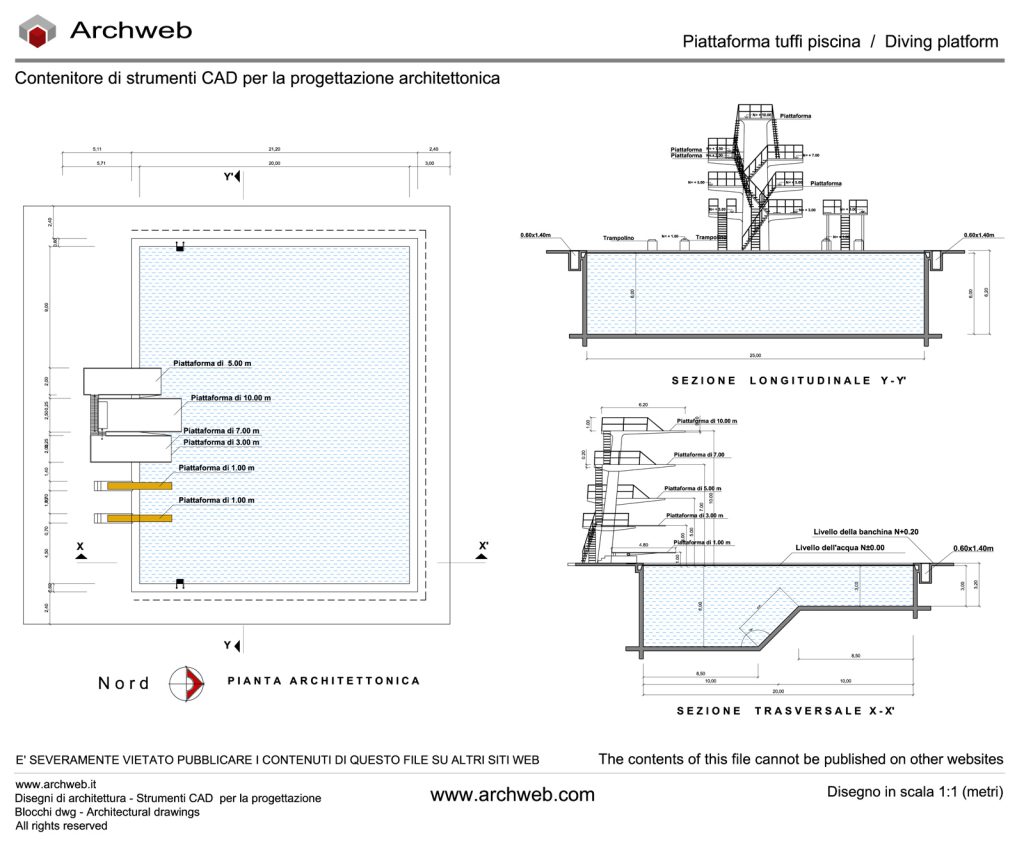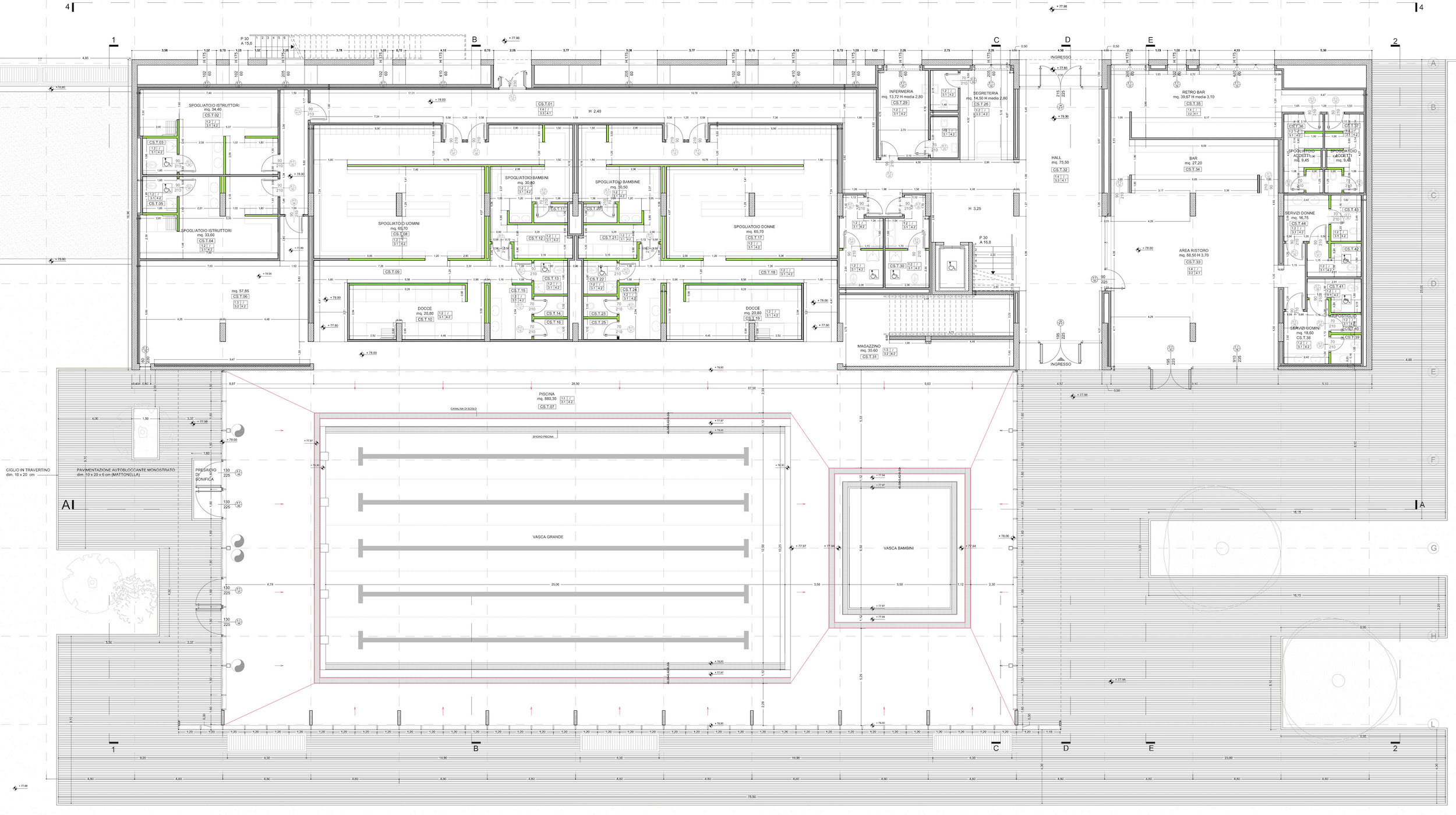Design sports pools for swimming
Thinking about the users inside and outside the pool is the key to the success of the swimming pool

A head-first dive into the design of swimming facilities: a semi-serious guide for designers who don’t know how to swim.
When you think of a swimming pool, the first thing that comes to mind is the pool full of water, with lanes, flags (which don’t cross the pool for beauty’s sake) and a few people swimming back and forth.
The pool is the fulcrum of the activity for which the sports facility in question is responsible, the dominant utilitas unfolds right there, people go there specifically to swim. But it is not certain that the tank and its specific plant system are the main theme of the project’s development.
You have to put yourself in the user’s shoes. Jokingly, it’s very little, we’re talking about swimsuits, even quite tight ones, plus a towel or bathrobe if you want to take it large.
Irony aside, we must consider a public which, however varied, has specific needs, different from those of those who access a hotel swimming pool, or a water park, i.e. pools not specifically dedicated to the teaching and practice of swimming and other even more specific sporting activities such as water polo, finswimming, synchronized swimming, diving and then aquagym, hydrobike, aquafit cross, and everything that the sports wellness industry can offer for soaking.
In this regard, several examples of tubs for wellness centers and garden swimming pools are also available on Archweb.
In this regard, several examples of tubs for wellness centers and garden swimming pools are also available on Archweb.
It cannot be said that every discipline needs its own pool, but it is quite clear that swimming lessons are fine in one and a half meters of water, while diving is best avoided.
Playing with words again, if class is not water, not even water is a class, in the sense that it is not sufficient to define a single typology, neither of project nor of user.
It would be enough to think about the swimmer (beginner or expert it makes no big difference) to put the focus of the project outside the water. It is taken for granted that this is adequate in terms of temperature, recirculation, filtration, sanitization, etc. and that the tub has the correct dimensions. There are specific standards, specialized companies and among the Archweb CAD drawings available for download there are several ready-to-use examples.

The swimmer is the user of the pool, he is demanding and he has reason to be demanding.
It was said to focus on the public, on the customer of the swimming pool, the person to whom the facility is mainly dedicated, the one who, with his attendance, loyalty and payment, keeps the sports facility alive and makes the investment profitable. Whether this is public or private makes little difference, because it is not just a question of a mere financial return, but of broader repercussions on the territory, on the health of citizens and also of a certain spin-off.
What does a swimming pool customer do?
At least two or three times a week the swimmer arrives at the facility, must park, log in, purchase a ticket, take off his shoes and put on slippers, have lockers available for storing objects, access the changing room, change, do the shower, wait for your turn to start, access the tub surface, hang up your bathrobe, leave your slippers, enter the water, swim and then repeat everything in reverse, plus dry your hair. And if after all this he also found a bar to refresh himself in, he might even like it.
Lots of stuff! Especially if you have some disability, or have limited motor skills, even temporary ones, due for example to an accident, or to some joints that need to be rehabilitated.
Usually, for obvious hygienic reasons, users access the pool deck exclusively through the changing rooms, but this must not also apply to staff (lifeguards, instructors, cleaning staff and, if necessary, healthcare personnel).
There should be, as far as possible, a certain difference in temperature and humidity between the internal area where you walk with shoes (entrances, ticket office, shoe changing area, etc.), the first aid area, the changing rooms, the showers and the pool surface, especially in winter. Both should grow gradually as you proceed from the outside towards the heart of the plant.
Once the swimmer enters the water he changes environment, he no longer has to deal with the “usual gravity”, he puts his head under and also begins to breathe differently, he is almost in another world. The rest of the system no longer interests him, given the same length of pool (25 or 50 metres), width of the lane and quality of the water, one system is almost as good as another.
When he puts his shoes back on, the perception of the quality of the service received and for which he paid, will derive above all from the staff (primarily the instructors) and from everything about the system that does not concern the swimming pool itself, of which he will remain aware especially the temperature, cleanliness and smell of the water, characteristics that the designer struggles to control and which can vary from one day to the next.
It should not be forgotten that the practice of swimming is particularly suitable not only for the physical development of young people and maintaining the shape of adults, but also for preventing and rehabilitating the most varied ailments, as well as for the motor activity of disabled people. In short, a lot of people are starting to go to the pool because the doctor told them to. This is not a fact to be underestimated, it means that he doesn’t really like it that much.
Among those who attend it because it is their turn, we must add some children encouraged by their parents (so they are a little more relaxed at the seaside) and those who are lucky enough to be able to use the facility together with their school friends. Several swimming pools, especially in the morning, work with school groups in winter and with summer centers during the summer. For children and teenagers they are also excellent opportunities for socialisation, which however does not happen much in the water, but rather in all those accessory pre-and post-swim phases.
For all these reasons, the designer can and must control various aspects: the quality of the spaces, accesses, paths, internal air and sunshine. They all have a strong impact on the quality perceived by the customer.
Furthermore, the ease of cleaning and control of public areas, the accessibility of the plant equipment and the functional rationality of the service environments will certainly be appreciated first by the plant staff, and consequently by the users and then by the management.

Plan of the swimming pool of the Romanina Sports Center – Blow Up Architecture – Noos Architetti – vg-hortus.it
The swimming pool is dangerous because you can drown. Definitely no. And those who swim don’t think so at all.
Aside from aches and pains, which could occur in any other sporting activity, swimming is a very safe activity, because it is practically free from any type of trauma. Furthermore, swimming is always under surveillance and the facility must provide first aid personnel and equipment. If we take away water polo and diving, which are specialist disciplines, in swimming there is never contact, you don’t jump or fall back to the ground, so ankles, knees and backs have very little to fear.
The problems don’t come so much from what happens inside the tank, but from what happens outside. In all swimming pools it is forbidden to run, on the pool surface and in the changing room, because if things go well you slip, if things go worse you take off and then fall back, the surfaces are hard (almost always tiles) and if there are sharp edges, damage they can only be more serious.
The designer must pay attention to all of this, not only in the choice of non-slip materials (which is the minimum, but sometimes the water is simply too much), but also in the design and arrangement of the elements and furnishings, in the layout of the paths , in the slopes for the flow of water, in short to everything that can reduce the “path risks” to the source.
When you are swimming in the pool you don’t live on water alone, you also need air.
As mentioned, the water in the tub has its own specific system and is subjected to precise daily checks, while the same cannot be said for the air in the tub surface.
Outdoors and in general during the summer the question does not arise, because even indoor swimming pools should always be equipped with large openings. But when it’s cold outside, you keep everything closed and the environment is heated, the quality of the air can suffer, except that it usually gives less importance to it than to water.
Also in this case it would be advisable to contact companies specialized in HAVC for swimming pools, because it is not just a question of sizing the system based on a certain volume of air, the natural convective motions that vary during the day and the seasons must be considered, the continuous heat exchange with a large mass of water at an almost constant temperature, as well as its evaporation which includes disinfectant substances potentially irritating especially for the eyes, nose and throat.
Swimming, perhaps at a fast pace (without necessarily being an athlete), together with several other people, in an environment where the air is too hot, humid and perhaps full of chlorine, means experiencing an unpleasant sensation of difficulty in catching your breath and also getting out of the tub can present problems, because the heat exchange that the body has with the water is abruptly reduced.
Natural convection, air recirculation, sunshine are elements that the architect can keep under control. And, as mentioned previously, the user pays attention to it, this is reflected in loyalty, the pleasure of going to the pool, turnover, and everything that goes behind it.
In the pool there are not only those who swim, there are other people, even outside the pool deck.
Leaving aside those who work there, we cannot ignore the fact that children arrive at the swimming pool accompanied by parents and/or relatives and the issue does not end in the car park. The swimming lessons are not so long as to allow the companions to do many other things in the meantime, just a little shopping on the fly, if the supermarket is nearby. Furthermore, especially the little ones should be helped to change in the changing room.
Wouldn’t you think that at least the number of people who can enter the “small pool” (i.e. children) should be doubled in relation to the size of the changing room? Maybe yes. Giving the mother the opportunity to hang her coat somewhere before dying due to the equatorial climate would be very nice… she is the one who pays for her child.
We certainly need to think that in the changing rooms there must be space for the clothes of twice the number of people who can enter the water: those from the current shift and those from the next.
The comfort of the changing room, the number of showers, the cleanliness of the toilets, the availability and safety of hairdryers are among the things that determine the quality perceived by the user. To retain the customer who can choose between our system and another approximately equidistant, we must also play on these details during the design phase, because additions are clearly more difficult.
The regulations provide indications and minimum standards, but the user does not know the regulations and certainly does not care that the minimum provisions are respected.
What do parents do while their children are at swimming school? They look at them. What do the children in swimming class do while their parents watch them? They greet them. Doing the strokes and at the same time greeting the mother, every stroke, in every tank, for the whole lesson, is a very difficult exercise, in fact even the teacher gets bored and the progress of the little fishes leaves a little to be desired. Adults should be able to watch without being seen.
Romanesque church galleries? Peepholes and hidden cameras? Or false mirrors like in interrogation rooms? Exaggerations of course, but we can invent something. Already asking yourself the problem is an excellent start to solving it.

The day of the end-of-course essay is a completely different matter. Grandmothers, aunts and cousins need grandstands, at least as for local youth competitions.
Well yes! There are also sports groups, pre-competitors, masters and we ignore the triathletes who even jump over ditches for long periods of time.
There will never be fans in a football stadium, but at least the paths and services dedicated to the stands must be well separated from those giving access to the changing rooms. It may be that a special ticket office is not needed, but the possibility of controlling access, the view of the staff on the stands and possibly being able to guarantee a minimum of orderly service would be appreciated by the management responsible for the facility, which could also coincide with the designer client.
And what does the “fan” do when there are races that don’t interest him that much (essentially those where his children don’t compete)? This is where the bar is also good again.
Cover image: Marcelo Uva on Unsplash
Other project references on sporteimpianti.it



































































